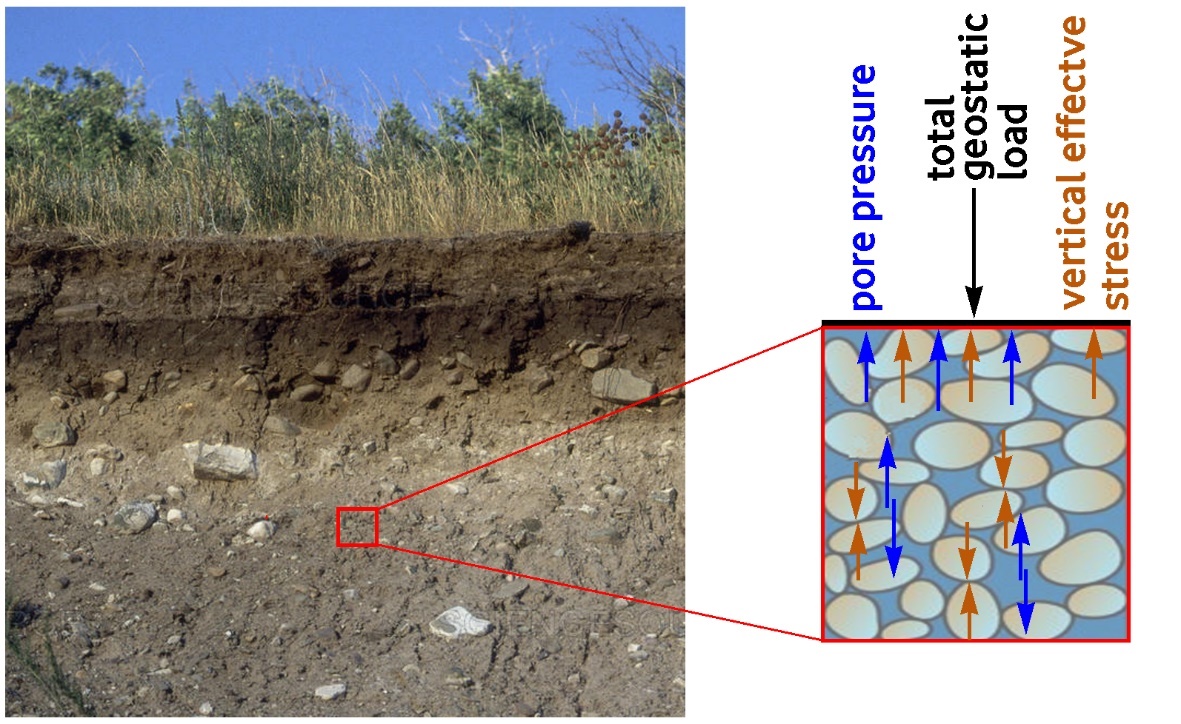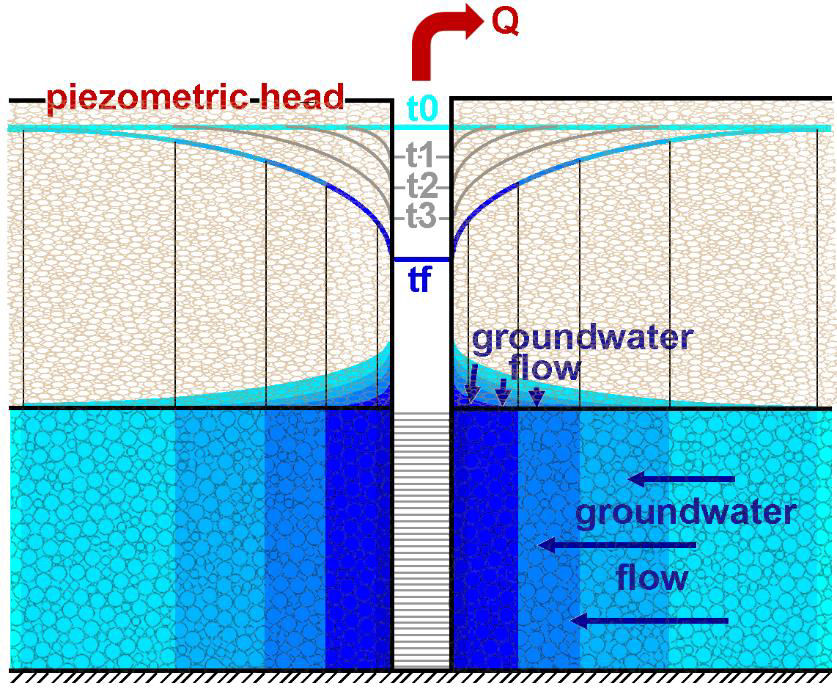1.1 General Concepts and Principles
The mechanism by which rock and sediments deform and compact under the influence of a change in pore water pressure is well understood. In aquifer systems the total geostatic load acting on the aquifer and confining beds is balanced by the pore water pressure and the effective vertical and horizontal stresses (Figure 1). When an aquifer is pumped, pore water pressure can no longer support as large a percentage of the load from overlying formations. Therefore, more of this load must be borne by the grain‑to‑grain contacts (effective stress) of the geological material itself, with a stress transfer from the fluid to the solid phase. This increase in effective stress develops in both the pumped units and the adjacent formations (that is, intervening aquitards and confining beds) that compact. The amount of compaction is primarily related to the compressibility of the compacting layers. The resulting cumulative compaction of subsurface layers extends its effect to the ground surface, which therefore subsides (Figure 2). Pore‑water pressure also can increase when water is added to an aquifer by natural recharge or injection. In some settings this may partially reverse, or mitigate, subsidence.

Figure 1 ‑ The total geostatic load is supported by the vertical effective stress (in red) and the pore water pressure (in blue).

Figure 2 ‑ Soil compaction η with a reduction of the porous space (grains are incompressible for all practical purposes).
The introduction of a pumping well into a natural fluid flow system produces a disturbance that propagates its effect in space and time through the geological medium. Around the well, a fluid head cone of depression develops and expands laterally, and to a minor extent also vertically (Figure 3). The magnitude and timing of the head drop caused by pumping depends on the distance between the well and the point of observation, the geometric, geologic configuration and boundaries of the subsurface basin and the geomechanical properties of both the fluid and formation: specifically, fluid density and viscosity and intrinsic medium permeability, porosity, and compressibility (Figure 4).

Figure 3 ‑ Groundwater withdrawal from a well causes piezometric head decline in the pumped aquifer (darker blue represents lower head) and, to a lesser extent in the overlying fine‑grained sediments. The piezometric head declines over time from the initial time (t0) level to the final time (tf) coned‑shaped distribution.

Figure 4 ‑ Main factors controlling land subsidence due to subsurface fluid removal are the magnitude of the reduction of pore water pressure in the pumped strata and its thickness and compressibility that control the resulting amount of compaction; then the depth and extent of the compacted material influences the magnitude and distribution of subsidence at the surface. When compaction is deep and of limited lateral extent, surface subsidence is less than when compaction is shallow and wide spread.
When a porous body experiences a change in the internal flow and stress fields, due, for example, to a sedimentation process producing a total stress increase, or to fluid pumping which causes a decrease in pore pressure, the incremental effective stress and the fluid‑dynamic gradient that develop are intimately connected. This connection was first recognized by Biot (1941), who developed the coupled theory of consolidation (and hence the coupled theory of land subsidence) where flow and stress are intimately. It states that fluid flow influences the porous medium’s deformation, which in turn affects the flow field. Groundwater hydrologists, who are mainly concerned with the fluid‑dynamic aspects of this coupled interrelation, have advanced the uncoupled theory of flow, based on the so‑called diffusion equation. Theis (1935) solved the single‑phase flow of groundwater by incorporating the rock structural properties into a lumped geomechanical parameter (that is, the elastic storage coefficient Ss defined in the next section). Theis’ solution to the diffusion equation is calculated separately, independently of the medium structural solution, in order to provide the pore pressure distribution. Once obtained, the pore pressure is used as the external driving force in predicting the medium deformation with a geomechanical model: in particular, the vertical displacement at the ground surface, that is, land subsidence.
Land subsidence has been documented to occur during some deep oil and gas reservoir pumping and during groundwater extraction. Let us compare anthropogenic land subsidence over gas/oil fields to that occurring over multi‑aquifer systems. Due to stress/strain redistribution in the thick overburden separating the reservoir from the earth’s surface, settlement above gas/oil fields is typically less than reservoir compaction, but it spreads over an area extending beyond the field itself (Figure 5a).

Figure 5 ‑ Character of surface subsidence caused by fluid pumping from the subsurface. a) Oil/gas withdrawal: because of the typically large depth D relative to the areal extent L, that is, a relatively small ratio L/D, the displacement field (red arrows) caused by hydrocarbon production is three‑dimensional. b) Groundwater pumping from an aquifer generally occurs from wells distributed over an area much larger than the aquifer depth, that is, L/D is large. Consequently, the displacement field is predominantly one‑dimensional, along the vertical direction.
Conversely, aquifer systems are generally shallower and have a much larger areal extent than gas/oil fields. In these systems, sediment compaction is not contrasted by overlaying deposits and simply migrates to the ground surface. Hence, such stratified systems behave mechanically as if they were one‑dimensional (1‑D) structures, and, although fluid flow may be three‑dimensional (3‑D) (to give a simple example, vertical in the confining beds and aquitards, and horizontal in the aquifers), land displacement occurs mostly in the downward vertical direction (Figure 5b).
In addition to dimensionality, other factors differentiate the mechanism of gas/oil field compaction from that of aquifer/aquitard compaction. Usually, both subsurface environments consist of a sequence of sands and clays or sandstones and shales. Sandstones are cemented sands, whereas shales are clays that have undergone extensive mineralogical changes in the burial process associating them with hydrocarbon‑bearing strata. These changes may have profoundly affected the shales’ compaction properties. Most freshwater aquifer systems are normally consolidated and normally pressurized, or only slightly over‑pressurized, and may lack important faults due to the typical formation mechanism involving a depositional alluvial/marine environment without significant interfering tectonic movements. However, their geomechanical simplicity may be partially offset by a litho‑stratigraphic complexity related to the distribution of clayey, silty, and sandy soils within the compacting system. It is well known that clay may be up to two orders of magnitude more compressible than sand at shallow depth (Chilingarian and Knight, 1960). Hence, land subsidence of a freshwater system highly depends on the distribution of the clayey and silty fraction within confining beds, intervening aquitards, and interbedded lenses. Moreover, drainage from these beds can lag behind drainage from the producing sand, thus causing a delayed land subsidence which may manifest itself after wells shut down (Figure 6). In contrast, in deeply seated gas/oil fields, clay (shale) and sand (sandstone) tend to exhibit the same mechanical properties irrespective of lithology (Finol and Sancevic, 1995; Baú et al., 2002; Ferronato et al., 2013), which further differentiates the magnitude and extent of subsidence above pumped aquifer systems and productive gas/oil fields.
Conceptually, four factors may combine to produce measurable aquifer settlement records:
- shallow burial depth of the pumped formations;
- highly compressible deposits laid down in alluvial or shallow marine or lacustrine environments;
- considerable pore pressure decline; and,
- large thickness of the depressurized water‑bearing strata.

Figure 6 ‑ Pore pressure depletion (blue dashed lines) in two aquifers and the intervening aquitard a) at the end of groundwater pumping and b) at some time after the well shutdown. The red‑hatched zone represents the portion of the confining aquitard experiencing pressure decline after the well closure, that is, causing delayed subsidence.
Unless the aquifers are over‑pressurized, factors 1 and 3 are mutually exclusive, while they can both be associated with factors 2 and 4. For a large subsidence to occur, however, a soft compacting deposit is needed, and/or a large pressure decline. To give a few examples, Mexico City sank by 10 m with a maximum pressure decline of only 0.7 MPa because of the extremely soft high‑porosity soils of the compacting shallow formations located within the upper 50 m (Rivera et al., 1991). Settlements of 9 m and 6.7 m were reported from the Wilmington (Rintoul, 1981) and Ekofisk (Hermansen et al., 2000; Zaman et al., 1995) oil fields in California, USA, and the North Sea, Europe, respectively. These large settlements were due to the pronounced pore pressure drop (exceeding 20 MPa in the latter) combined with the considerable thickness of the compacting units. Although land subsidence above hydrocarbon fields is outside the scope of this book, it is perhaps worth mentioning that at Ekofisk the reservoir rock exhibited a sudden increase in compressibility at some stage of the field development, with a large irreversible deformation defined as ”pore collapse”, believed to be the main reason for the unexpected large settlement over the field (Zaman et al., 1995).
Some aquifers may be over‑consolidated (Holzer, 1981). Over‑consolidation tends to reduce the early subsidence rate and then generate a sudden unexpected growth at some stage of extraction when the effective stress exceeds the pre‑consolidation stress. If the water‑ or gas/oil‑bearing sediments are pre‑consolidated it may be very difficult to predict anthropogenic land subsidence prior to the field/aquifer development. A pre‑consolidation effect might have been caused in the geological past by uplift followed by erosion of the sediments overlying the fluid‑bearing layers, by fluid overpressure, or both (Maltman, 1994). When pore pressure drops due to fluid removal, a reloading of the pumped formations takes place. Initially, compaction is slight, and thus, land settlement is also slight. However, as soon as the maximum experienced load is surpassed, rock compression occurs on the virgin loading curve with a sudden increase in compressibility and subsidence rate. Another factor that may influence the process is the presence of faults within the developed system and the overburden, as in the case of Las Vegas, NV, USA (Amelung et al., 1999). Faults may weaken the porous medium structure and make both analysis and prediction more difficult.
For the sake of completeness, we should mention other types of anthropogenic land subsidence that are not addressed by the present analysis. Most of them are less important in terms of socio‑economic and environmental impact. They include underground mining, carbonate rock solution, subsurface erosion, surface loading, land drainage and reclamation, histosoil (peat) oxidation, dissolution of soil carbon and water application (Allen, 1984). An example of land subsidence due to peat oxidation is presented by Zanello et al. (2011).
